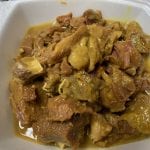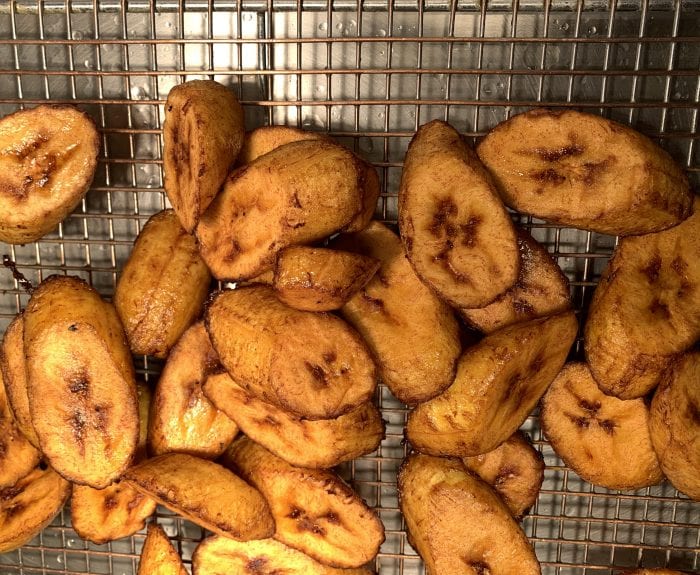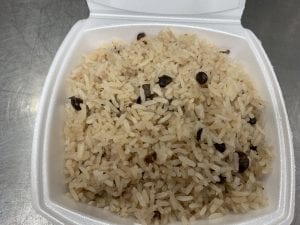Side of Goat
Side of Curry Goat
Our goat meat is succulent tender and rich with less saturated fat, calories, and cholesterol than other red meats. Chunky pieces of the goat are slowly simmered in aromatic blend garlic, allspice thyme, onions, and with Jamaican curry taking center stage until the sauce is thick and creamy. All of the flavors melt into the goat meat and creates a really wonderful dish after a few hours.
Jamaican Curry Goat is an insanely delicious, slow-cooked Jamaican Spiced Curry that is full of flavor and tender to the bone! An absolutely must have at any Jamaican restaurant.
This creamy and satisfyingly delicious Caribbean curry goat, best served along with rice and peas, is made with goat meat cooked until tender, fresh spices, and so much flavor in every bite.
If there were ever a dish that screams comfort food, it’s a beautiful hot plate of curry goat. Some spices and aromatics really make this hearty dish so spectacular. These flavors come from onions, scallions, fresh thyme, scotch bonnet pepper, allspice, and garlic.
Once everything is in the pot, you let it cook up until the goat becomes tender. You just can’t get enough of it, which is why we included a side of curry goat available on the menu for ordering.
All of the flavors meld into the goat meat and creates a wonderful dish after a few hours. You get a hint of heat from the scotch bonnet pepper, which bears a resemblance to a typical habanero pepper. Near the end, you’ll throw in some chopped potatoes, and they soak up all said flavor too.
I always find myself sneaking a piece out of the pot before it’s done. It’s nothing like the finished product when the goat is so tender that it falls apart with a fork, drool. Order a side of curry goat to have a truly filling meal!
Side of Oxtail
Side of Oxtail
Oxtail is a-rich meat, slow-cooked with butter bean as the main dish (with rice)most popular in, Jamaica, and other West Indian cultures. Our oxtails are rich with flavor, perfectly cooked until the meat nearly fall-off-the-bone with creamy butter beans. Our flavors come from onions, scallions, fresh thyme, allspice, and garlic. You just can’t get enough of it which is why we included a side of oxtail in the menu available for ordering.
Coco Bread
Coco Bread
Coco bread is the Jamaican version of buttery and sweet yeast-risen dinner rolls. In New York City, they are often sold wrapped around a Jamaican beef patty with a slice of American cheese, but at Miss Lily’s in Manhattan, the chef Adam Schop serves them with garlic butter flavored with thyme, a commonly used herb in the Caribbean. Note that the origin of its name is up for debate: Some say original recipes called for coconut milk, others that the dish is named after a similarly named brand of Jamaican butter. Yummy! Very easy to make. Enjoy!
Jamaican Beef Patties (Beef or Veggie)
A Jamaican Patty
These flaky Jamaican meat patties contain curried ground beef with great flavor. This includes onion, garlic, and Scotch bonnet pepper, plus a slew of aromatic herbs and spices. Eating them is almost as good as an actual trip to Jamaica.
What is it?
The Patty is a pastry that contains various fillings and spices baked inside a flaky shell, often tinted golden yellow with an egg yolk mixture or turmeric. It is made like a turnover, but is more savory and filled with meat.
As its name suggests, it is commonly found in Jamaica and is also eaten in other areas of the Caribbean, such as the Caribbean coast of Nicaragua and Costa Rica. It is traditionally filled with seasoned ground beef, but fillings can include chicken, pork, lamb, vegetables, shrimp, lobster, fish, soy, ackee, mixed greens, or cheese.
In Jamaica, the Patty is often eaten as a full meal, especially when paired with coco bread. It can also be available as bite-sized portions called cocktail patties. Among the Jamaican diaspora in the UK, the pastry is more like that of a suet crust. Margarine or butter then makes it a flaky pastry. Flavors come from curry powder containing turmeric, which provides the flavor.
History
The beef patty is a product of colonialism and migration developed after the introduction of the Cornish pasty in the Caribbean, mixed with cumin and curry seasonings of Indian indentured servants in Jamaica and cayenne pepper from African slaves. “The firecracker taste of the Scotch bonnet, a hot pepper indigenous to Jamaica, sealed the flavor.”
Jamaicans brought recipes for the patties northward in the 1960s and 1970s. Thereafter went to the United States as hospital orderlies, home health aides, and nurses. The patties were then found in restaurants in areas of the New York Metropolitan Area with high West Indian populations. The patties are equally famous in UK cities with large West Indian communities, such as Birmingham Manchester, and London.
Why the Patty?
Their popularity is spreading in the UK, and they are becoming available in many mainstream outlets. They are also popular in Toronto, Montreal, Washington, DC, and numerous other areas throughout the American northeast and Canadian Great Lakes regions; in many of those areas, they are available in grocery stores, delis, corner stores, and convenience stores. For the past few years, the Jamaican meat patty has been pre-made and frozen. This makes it possible for mass selling in Britain, Canada, and the United States.
In many areas in Canada and the US, Jamaican beef patties are at pizza and convenience food restaurants and supermarkets.
Plantains
Plantains as Side Dish
This traditional Caribbean side dish adds a subtle sweetness to any meal. We use plantains with heavy black spotting to entirely black skin.
- Plantains are not bananas, although they are related to the banana they are not suitable to eat raw and must be cooked. (Yall know I would have tried to eat it fresh had I not read this)
- They are starchy and often used as a vegetable the same way we would use potatoes. It is usually fried or baked. They are very popular in West Africa and Caribbean countries.
- A regular banana is ready to eat when the peel is yellow; however, plantain is considered ready to eat when the skin is black or almost black
- They are a good source of potassium, vitamin A & C. They are also high in fiber and used as an energy booster!
Steam Cabbage and Carrots
Steamed Cabbage and Carrots
Our steamed cabbage and carrots recipe is a simple yet tasty side dish consisting of lightly seasoned steamed cabbage, bell peppers, and carrot. We shred our cabbage and carrots then cook them with onion, garlic and bell pepper. Our dish is low in carbohydrates and saturated fat.
White Rice
White Rice
White rice is milled rice that has had its husk, bran, and germ removed. This alters the flavor, texture, and appearance of the rice and helps prevent spoilage and extend its storage life. After milling, the rice is polished, resulting in a seed with a bright, white, shiny appearance.
The milling and polishing processes both remove nutrients. A diet based on unenriched white rice leaves many people vulnerable to the neurological disease beriberi, due to a deficiency of thiamine (vitamin B1).
It is often enriched with some of the nutrients stripped from it during its processing. Enrichment of white rice with B1, B3, and iron is due to a requirement by law in the United States. As with all-natural foods, the precise nutritional composition of rice varies slightly. This depends on the variety, soil conditions, environmental conditions and types of fertilizers.
Adopted over brown rice in the second half of the 19th century because it of traders’ preference, this type of rice has led to a beriberi epidemic in Asia.
At various times, starting in the 19th century, people have advocated brown rice and wild rice as more healthful alternatives. The bran in brown rice contains significant dietary fiber and the germ contains many vitamins and minerals.
Typically, 100 grams of uncooked rice produces around 240 to 260 grams of cooked grains, the difference in weight being due to absorbed cooking water.
Rice and Peas
Jamaican Rice and Peas
Our dish is made with rice and pigeon peas (known as gungo peas) the combination of grain and a legume forming a complete protein; compare to rice and red peas. Scotch bonnet pepper, thyme, scallions, and coconut milk are then added along with the rice and left to simmer until cooked.








































